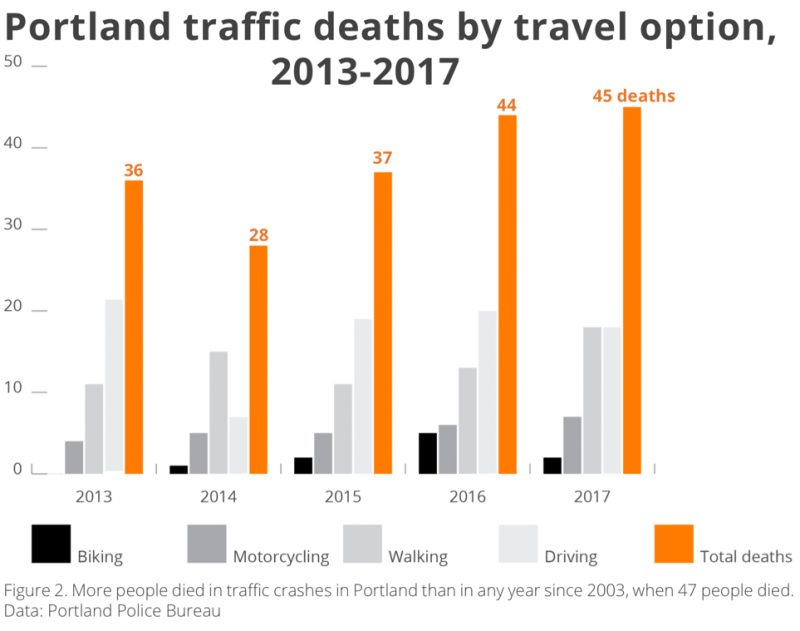
We haven’t turned back the rising tide of deaths and injuries on our streets; but we’re getting better at analyzing it and we’ve laid the groundwork for future progress.
That’s the vibe from the Portland Bureau of Transportation as noted in their first annual Vision Zero Progress Report published yesterday. Stating that 2017 was, “A year of tragedy and foundation building,” the agency detailed their policy and project efforts and offered a sad recap of all the traffic deaths last year.
Here are our takeaways…
The clock is ticking
We’re almost three years into our Vision Zero era. The resolution passed by City Council in June 2015 committed us to achieving “zero deaths and injuries” by 2025. Don’t look now, but we’ve only got about seven years to turn this thing around.
As you can see in PBOT’s graph, the uptick in deaths began around 2010 and overall deaths have gone up each year since 2012. The 45 deaths PBOT counted in 2017 (there were six other deaths excluded because the person, “died of causes not directly attributable to a traffic crash”) were the most since 2003. To reach our goal Portland needs to take even more “aggressive measures” and have even more “courageous conversations” — to use the words of PBOT’s own Director Leah Treat from a Vision Zero Task Force meeting two years ago.
PBOT echoes that sentiment in the new progress report by stating that, “Eliminating all traffic deaths and serious injuries by 2025, while achieveable, will require considerable continued effort by the City of Portland and residents.”
Deaths aren’t the only measure
The conversation around Vision Zero mostly revolves around how many people die; but let’s not forget all the survivors whose lives are changed forever by our dysfunctional relationship with motor vehicle use.
One stat that jumped out at me in the report was that 275 people suffered an incapacitating injury in 2016 (2017 numbers aren’t available yet, but given other trends it’s probably inching close to 300). That’s over five people per week. And that doesn’t even count all the stress and emotional trauma suffered by families and friends.
Advertisement
A good effort on speeding
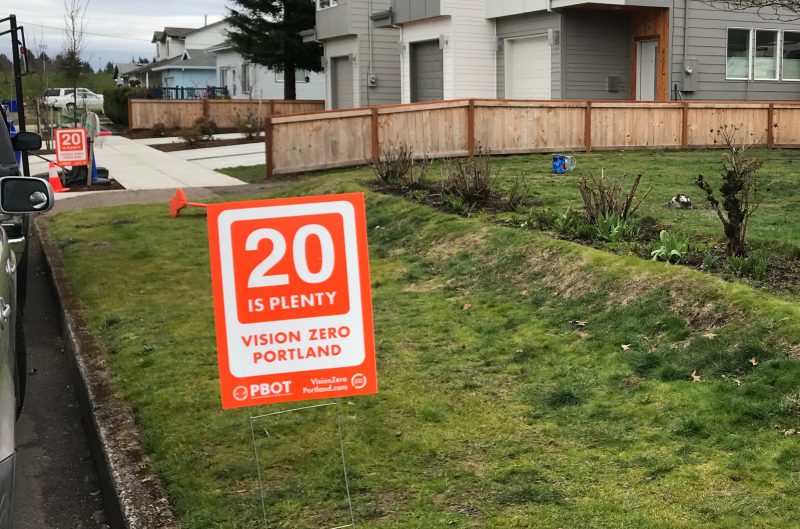
(Photo: J. Maus/BikePortland)
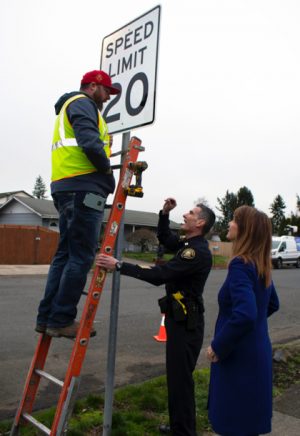
(Photo: PBOT)
The biggest bright spot in PBOT’s Vision Zero efforts thus far has been in lowering speeds. They’ve wrested authority away from the State of Oregon to change speeds on local streets, they’ve passed a new residential speed limit law, they’ve installed speed cameras, and they’ve worked with the Portland Police Bureau on regular enforcement campaigns.
While not directly related to speed policies, PBOT’s continued work to install traffic calming infrastructure — primarily through the neighborhood greenway program — is having a very positive impact on making people slow down. On a related note, they’ve also ramped up their speed-related educational campaigns. Earlier this month PBOT began handing out free “20 is Plenty” yard signs and I’ve already seen dozens of them in people’s front yards throughout the city.
Another bit of news from this progress report is that the City is developing a “Safe Speeds Save Lives” campaign that will launch this spring. They’ve already outfitted 1,000 vehicles in their city fleet with bumper stickers.
The who, when, and where
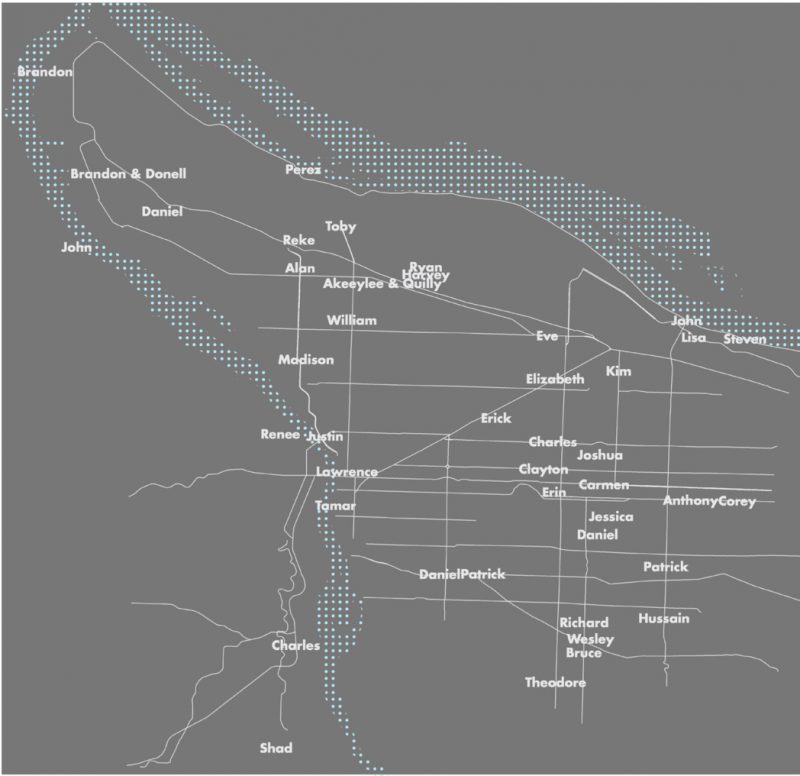
I’m pleased to know that PBOT understands this is whole thing isn’t just about policy and projects and data — it’s about people. Who dies and where and when it happens matter just as much as the more wonky details. Throughout their Vision Zero efforts I’ve noticed PBOT staff have put an emphasis on the people who’ve died. You can see most clearly in the graphics and reports they produce.
In 2017, fall was the deadliest time of year with October and November both recording eight deaths each. The median age of a person who died was 43 and victims ranged from 12 to 87 years old. In our own unofficial tally of last year’s fatalities we found that 60 percent of them (28 out of 47) happened after 6:00 pm and before 3:00 am.
We frequently cover the fact that the vast majority of Portland’s traffic deaths happen on big arterials (many of which are still unfortunately controlled by ODOT). In 2017, 69 percent of all deaths occurred on streets PBOT has labeled part of the High Crash Network. That number, “Indicates that street design remains an important factor in preventing traffic deaths and serious injuries,” reads the report. Demographics matter too. One in three deaths last year happened in a place with lower-than average incomes and higher than average amount of people of color.
Here’s a list of the 51 people who died on our streets last year (I’m including the six unofficial ones too):
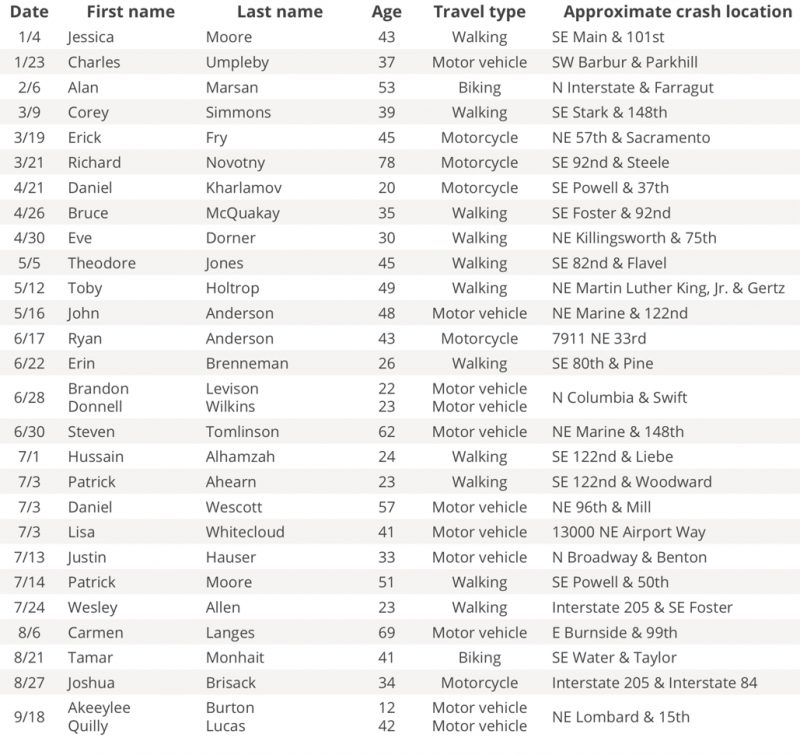
There’s no hiding from this list. To say it will take, “Considerable continued effort” to make it disappear is a huge understatement.
Keep track of the City’s Vision Zero progress here.
— Jonathan Maus: (503) 706-8804, @jonathan_maus on Twitter and jonathan@bikeportland.org
Never miss a story. Sign-up for the daily BP Headlines email.
BikePortland needs your support.








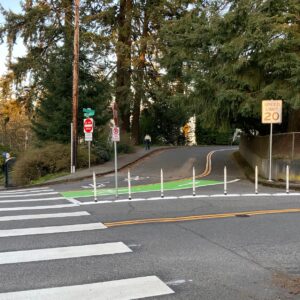
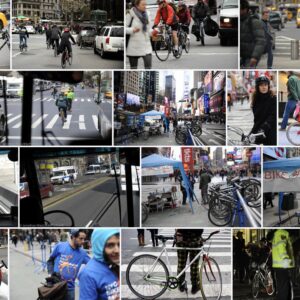
Thanks for reading.
BikePortland has served this community with independent community journalism since 2005. We rely on subscriptions from readers like you to survive. Your financial support is vital in keeping this valuable resource alive and well.
Please subscribe today to strengthen and expand our work.
Oh my God. Seeing the walking line match up with the driving line is actually pretty horrifying, to be honest. I imagine those are mostly just innocent people being run over by drivers. I didn’t realize it had gotten so bad. I might switch from walking to rollerskating when I’m not on my bike or in my car. I notice nobody got killed on rollerskates.
We will not really solve this problem without one of two things. a) More enforcement of all traffic laws or b) stricter testing and retesting of drivers with the intention of weeding out 10% or more of the driver population. Just today I watched a car make a sharp turn across the tracks,20 feet in front a max train at speed, and two other cars go up short one-way streets to save themselves time. When you head out on the roads it is like getting a ticket to the circus and when you bike it is like getting a front row seat where the lions can eat you.
My only riding today consisted of six miles of bike path and two miles of residential streets. The bike path was blocked by private vehicles in two places; this doesn’t surprise me any longer. On the streets, I had six motorists illegally drive over the center of the roadway and come closer to me than is safe, three of them while I was hauling my two granddaughters on a tandem+trailer bike. Of course there were numerous (over 80%) cars driving at least 5 mph over the posted speed limit and two people who would have doored us but we don’t ride in the door zone. And then there were the three drivers who ran red lights and seven who ran stop signs at the few controlled intersections we dealt with. And this was a relatively good day for motorist behavior.
How are any of those miscreants going to learn how to use their vehicles in a safe and legal manner without the education provided by citations? Fines are like tuition and we need to enroll more motorists in this education program.
There were those of us who said…
…patience, one year does not a trend make.
I suspect that changes in traffic deaths are pretty closely correlated with vehicle miles traveled in the metro and that the (pretty limited, in my experience) attempts at implementing Vision Zero policies are not really doing anything at all. I have _never_ seen anyone pulled over in the metro for a speed limit violation and agree with bikeninja that would be a good start, along with maybe enforcing the law that requires signaling turns.
Gotta be more like common sense countries that make it difficult and expensive to drive. And, while we’re at it, difficult and expensive to own a gun. Let’s go!
I would also like to see more enforcement and for Oregon / Portland to get serious about people driving without insurance. I realize there are equity concerns around this, but the consequences of continuing to let people unsafe vehicles, especially without insurance, is disastrous. Keep bolstering transit and bike networks and get uninsured drivers and unsafe vehicles off the road (in motor vehicles).
There were 956 police officers in Portland according to the FBI in 2011 (the last year with such stats) from all agencies, but mostly from the City of Portland. This works out to approximately 150 officers per 100,000 people. According to Wikipedia, the US average is 284 officers per 100,000 in 2015, while in the Netherlands it is 381 officers and in Sweden 192, though there the difference between police and the military is a bit blurry. My point is that Portland is way under-policed compared to most of the Vision-Zero world. Since Portland residents are unwilling to impose a regressive local sales tax, as Ashland Oregon already has, and unable to substantially raise local property taxes due to state restrictions from the 90s, you are left in an unfortunate position of rationing your police resources: is traffic enforcement your priority, or fighting violent crime, or drug addictions, or property crime?
https://ucr.fbi.gov/crime-in-the-u.s/2011/crime-in-the-u.s.-2011/tables/table-78-state-cuts-2011/table_78_full-time_law_enforcement_employees_oregon_by_city_2011.xls
https://en.wikipedia.org/wiki/List_of_countries_and_dependencies_by_number_of_police_officers
1. Comparing an entire nation to a metro region.
2. In Europe many civilian police are members of the military: https://en.wikipedia.org/wiki/Royal_Marechaussee
The City of Portland spends half a billion dollars on public safety each year with little to show for this other than a pattern of civil rights violations:
https://en.wikipedia.org/wiki/United_States_v._City_of_Portland
The Portland Police Bureau’s budget was closer to $200 million in 2017/18, nowhere near $500 million.
Most of the city’s annual $600 million “public safety” budget goes to the Fire Bureau, which is usually the last department to see any cuts, since a cut to fire protection directly affects a city’s bond rating and it’s ability to borrow and the interest rate it pays. In 2017 government debt was 14.7% of the city’s $1.3 billion budget.
Jonathan, As always, thanks for your diligent analysis on a very important issue. I’m most curious about what progress has been made in NYC & San Francisco. It looks like they’ve improved a bit…
https://visionzeronetwork.org/vision-zero-buoyed-by-progress/
and at least we are not LA, right? Looks pretty grim…
http://www.latimes.com/local/lanow/la-me-ln-vision-zero-20180227-story.html
My questions are similar. Let’s get an across the board comparison with other jurisdictions pursuing the same goal. Are they struggling similarly or leaving us in the dust. If the latter, what is PBOT’s explanation?
Secondly, Vision Zero is NOT just about eliminating deaths, but deaths and serious injuries.
– In 2017, 69 percent of all deaths occurred on streets PBOT has labeled part of the High Crash Network. That number, “Indicates that street design remains an important factor in preventing traffic deaths and serious injuries,” reads the report.-
While street designs may well contribute to the CARnage, I’m not sure that the fact that most deaths occur on certain streets indicates that is the case. What fraction of cars travelling over 40 mph are on those streets? If it’s in excess of 69%, then the design may not be the issue at all, other than the fact that the street design allows for a speed that is known to be far deadlier than 20 mph.
It’s this sort of close-minded “we know everything we need to know” attitude that causes me to almost give up hope. The people implementing Portland’s Vision Zero program are the same people who took traffic law enforcement off the table without any supporting evidence that one could significantly reduce traffic death without significantly increasing enforcement. Has it ever occurred to the people at PBoT that maybe, just maybe, they are guilty of having a limited tool box and are failing at so much of their mission (see, for example, the increased number of traffic deaths and injuries coupled with the flat or decreasing cyclists and pedestrian mode shares) because not all problems are nails to be struck by their hammers?
Any attempt to increase enforcement in Portland – be it of dangerous driving or street crime, car theft or drug dealing – immediately gets bogged down in the equity morass.
That strikes me as too simplistic, and an easy swipe. While I agree with those who have suggested here in the comments that the city or county be more proactive about tackling or at least communicating their approach to enforcement that seeks to avoid the historic and well documented racial bias, your comment suggests there is some easy fix that we are unable to grab because of what you derisively refer to as the ‘equity morass’. We’re it but so. Can you point to another US city that has solved this already?
The stats suggest the traffic enforcement division is much better than the police force as a whole on measures of bias. I’m not sure we have a significant traffic enforcement problem. I believe the issue is pretext stops, which are a different beast altogether.
I think PBOT surrendered to “equity concerns” without thinking critically about the issue.
This is important.
Can you link to those stats? I’m curious.
“without any supporting evidence that one could significantly reduce traffic death without significantly increasing enforcement”
I note that you *assume* enforcement is effective but fail to provide any evidence.
Sweden, the UK, and the Netherlands all dramatically reduced traffic fatalities — and especially pedestrian fatalities — while deemphasizing human enforcement. Perhaps infrastructure and speed reduction does work. It would be nice to see our political leadership and PBOT commit to fund these things on a scale that might actually have a chance of working. A few piecemeal improvements and a bunch of excuses about ODOT is a recipe for failure.
When one has already put in place extensive enforcement, much of it automated, it’s easy to do more without emphasizing enforcement. We’re in a different place altogether with essentially zero enforcement.
Seriously, would you expect to receive a citation for driving 34 mph in a 25 mph zone, or would it surprise you? Would you expect to get a citation for rolling a stop sign in your car at 3 mph or would it surprise you? Do you really think you have to stay in your lane while driving? All of those actions have impacts on deaths and injuries on our roadways, but we continue to clutch our pearls and lament our lack of partially separated bike lanes. Most of the pedestrians have grade-separated infra for most of their trips, but still have to deal with intersections and get struck while doing so.
The city has well-paid public relations staff in every bureau.
Your point being?
do you really need an explanation? It should be self-explanatory unless you are asking a rhetorical question.
I’m not asking a rhetorical question; I don’t understand what your statement has to do with the topic we’re talking about, how it helps us understand our predicament.
Traffic deaths are up, a PR statement is released about vision zero. A few questionable ‘improvements’ are made proposed for already safe ‘greenway’, another PR campaign is mounted. No real change, but lots of PR.
That is a glib and in my view premature inference. I don’t think we have enough information to place blame. However I suggested upthread some ways we could try to figure out if your ungenerous indictment of the effort is fair or accurate.
We all want change to happen faster. But if you can’t step back and see the trend that is building, rather quickly actually, then I don’t think you’re paying attention. Yes, I want a protected bikeway on every street (I actually don’t, that’s rhetorical), but there’s a relatively huge amount of stuff happening, and it seems to be building momentum.
Agreed.
And I think it might be instructive here to compare and contrast how ODOT and PBOT are proceeding on fronts we notice and care about here on bikeportland.
My take: ODOT drags its feet, jams sticks into the spokes, pretty much at every opportunity. Nothing they do comes across as in any way tuned into the way we see the world; no bones are thrown our way. PBOT on this topic and others, however, is in fact making genuine efforts, has the long game in view, though they occasionally stumble, are timid, too slow, etc. But one can make out the earnest intentions and occasionally actions that align with them.
Do others see this differently?
IMO the only real difference between PBOT and ODOT is that PBOT is much better at public relations than ODOT is when it comes to spinning benefits for non-motorized users; otherwise both organizations are pretty similar in terms of both actions and accomplishments. You may think PBOT has accomplished more, but that’s because that’s what they want you to think; the quality of many of PBOT’s so-called improvements is quite poor and leaves a whole lot to be desired.
Thanks, Buzz, for your comment.
“You may think PBOT has accomplished more”
And for helping me clarify something.
I didn’t claim that PBOT had accomplished more, but rather that they were “making genuine efforts.” At some point we’ll need to take stock, ascertain whether their efforts are bearing fruit.
9,
like maybe more than one year out from the beginning of changes? How about a year after funding began (January)?
sure, p.
I’m not too worried about the specific time frame, but I am interested in accountability, and am allergic to condemnations that are not supported.
That department PR is a waste of money that should go to more important services.
The increase in deaths is a morbid measurement of how long it takes the city to adapt to population growth.
At some point, with sufficient growth, the number of traffic deaths will just balance out in migration, and our housing crisis will be over.
It is the deaths of people walking that account for the increase. It will take all tools applied for all modes to actually get the numbers down.
Hmm, vulnerable road users who have a vast network of grade-separated infrastructure account for the dramatic increase in roadway deaths. How could that be? Almost every regular commenter on this site implicitly accepts that if we just built an extensive network of grade-separated bike infrastructure our woes would cease. Time for a rethink, perhaps?
fun fact:
the 7 states + DC who legalized marijuana since 2012 have seen a >16% increase in pedestrian deaths, while the rest of the states saw a cumulative 5.8% decline.
But pedestrian infrastructure is mostly NOT grade-separated where it crosses motor vehicle infrastructure. It is at those crossings where the casualties occur. That doesn’t mean pedestrians would be better off without grade separation, not would cyclists necessarily be better off with less grade separation than more.
Let me elaborate on that a bit more: most cyclist-motor vehicle collisions also occur at intersections, not in bike lanes mid-block. On its own (without dedicated signal timing) grade separation may not necessarily reduce these collisions. Getting hit from behind while JRA, while one of the biggest risks that scares away novice cyclists, is actually a relatively infrequent occurrence in urbanized areas.
But that’s just it! Perception becomes reality. The more separated bike infrastructure we build, the more people are comfortable with it and start using it. And as we all know from Portland’s experience, the increased number of riders makes riding safer for us all.
Speed reductions on high crash corridors would help, especially coupled with serious efforts to reduce distracted driving. Reduced speeds increase distracted driving. Crash severity goes down but crash frequency could go up unless we can reduce the induced distraction. The resulting net misery is hard to predict. So far they only seem to be ignoring the distraction issue. All the people I talked to about that loophole they fixed didn’t even know it existed in the first place. They don’t even want to discuss the issue, as if it’s completely off the table.
Only a handful of the crash corridors are owned by PBOT _and_ not tied down by external factors (Marine Drive and the levee / flood issues). BH Highway is not ODOT in city limits and it is getting safety additions _later_ this year. They might ask ODOT for a lower speed limit of 30 or 35 mph for the majority of it.
Most of the deaths however are in East Portland on PBOT facilities, such as Stark, Foster, 122nd (and all the other numbers except 82nd), Division, Airport, & Marine Drive. Only Powell, outer Sandy, 82nd, and the interstates are ODOT. PBOT’s record on those streets is abysmal. They fund projects but never build them. Mayor Adams had to hound them to build the sidewalks they did out there, but when he left, PBOT stopped building anything altogether.
I’m curious about what has changed since 2010 to cause an increase in fatalities. Is it more cars, bikes and pedestrians on the road? Is it faster speed limits? Less enforcement of traffic laws? Is the difference just statistical noise given the number of passenger miles we’re talking about?
Is there any research into the causes of the national or regional uptick?
(subconscious) aggression traceable to a creeping sense that automobility’s days might be numbered?
Mayor Adams left, and Portland government has been weak and spineless ever since.
The miles driven per person metric nails it on the head, especially for Portland. It has been said 50 times on here: more people, high cost of housing, people spreading out, driving further.
And of course distracted driving, that is the big nationwide one.
iphone! original iphone was released in 2007. In 2010, support for the original iphone ceased when the iphone4 was released. Then all other companies tried to keep up/catchup/etc. Now when you are driving you can surf the internet, text your friends, and miss crosswalks and redlights!
have you reviewed the year to year numbers for fatalities, or the comparison to the year to year population growth, or better, the fatals per 100k population chart?
I’ve thought about that too. As the population rises, so does the number of crashes and injuries. But the problem isn’t defined as reducing injuries to a minimal percentage. The problem is that “Vision Zero” is about whole numbers, who has died or been severely injured, a total number that should be no more than zero. So percentages don’t count.
Igor,
Data review indicates that, after about 2008, traffic volumes in Portland went way down. Current volumes are back up to what they were in 2007, so there has been an increase in exposure (number of interactions) since 2010.
Vision Zero should be a policy not just for the City of Portland, but for the State and every county and city in the state. All of these bodies, and their police forces and road agencies need to be onboard to develop a statewide coordinated approach to protecting the lives of the people in this state. That means that ODOT needs to stop kowtowing to freight interests and work with everyone else to make the roads safer for all users. Automated enforcement is absolutely essential if we’re not going to increase the resources being devoted to the multitude of different law enforcement agencies in the state. The advantage of automated enforcement is that it doesn’t discriminate between races, genders or economic status.
I often ask why we need so many different law enforcement and road agencies (among others) in this state. I really think we are over-governed.
“The advantage of automated enforcement is that it doesn’t discriminate between races, genders or economic status.”
Perhaps. I really don’t know. We have cops who plant guns on suspects, shoot to kill and get away with it, so is it that hard to imagine bias creeping in between the machine taking the photo and the notice being sent out? I don’t know that this happens, and am in principle very much in favor of these cameras, but I’m leery of assuming too much about how fair this might be in practice. Perhaps someone here knows how this actually works?
At present, an affirmation of innocence (it wasn’t me driving that day!) is an allowable defense for a speed camera ticket. If I understand this correctly there is a police officer in the loop because someone has to decide that the photo image can be identified as the owner of the car. If the photo can’t be identified there is no citation. Also, if a ticket is paid but the driver is not identified nobody gets points on their license (don’t ask how I know this!)
If the “it wasn’t me” defense goes away this also drives up the cost of owning a car. Bummer. I would support having the owner of a car be responsible for any traffic violations committed using the car, with burden of proof on them if it’s another person. If I let an irresponsible person use my car and they break traffic laws and hurt people, is that not my fault? If I tell the person to drive carefully and legally and they don’t, is that not their fault? Should I not report them as the guilty party?
It’s BS that a car can be observed breaking traffic laws but nobody is to blame. It’s crazy that we require a judgement call by a trained officer whether a photo is of me or somebody else. If we take officer discretion out of the loop, there goes any possible bias. There are other things for police to do besides scrutinizing those photos.
The statute also says they have to be going 11 MPH over the speed limit to be ticketed. That’s some carhead right there.
thanks, x.
Look at the map and list of where people died. The great majority of the traffic deaths were in East Portland or far North Portland, on high speed arterial roads. Focus on the location of pedestrian deaths and that is even clearer.
What’s different there? Primarily high traffic speeds and poor crossing facilities. Sure, there are fewer bike lanes, but that is not a significant cause of deaths.
We (PBOT, ODOT) urgently need to slow traffic (speed limits, speed displays/cameras, enforcement) and improve crossings (crosswalks, signals, lighting, bumpouts, refuge islands) on high speed arterial roads in E and N Portland.
Do those now.
Other infrastructure improvements like road diets and bike/transit lanes are needed but will take longer.
In close-in Portland, understand that the primary effect of bike infrastructure improvements will be to increase active modeshare, rather than reduction of traffic deaths.
Also look at the time of day. Well over half the deaths occurred when the sun was down. Poor visibility is a big issue.
Anyone who has looked at the Vision Zero plan knows that this geographic disparity was already identified, hence the focus east of 82nd Avenue.
“We haven’t turned back the rising tide of deaths and injuries on our streets; but we’re getting better at analyzing it and we’ve laid the groundwork for future progress.”
This reads like satire aimed at our bureaucracy. Sad, dark satire.
Laying the groundwork. Always laying the groundwork.
People driving should fear for their savings account when they speed. But they don’t and they won’t unless Ted Wheeler et al. get comfortable with offending drivers who feel entitled to use our roads as their aggression outlet.
More enforcement. With fatality levels like we’re seeing, freezing enforcement is criminal.
An interesting study
http://www.wweek.com/news/2018/03/01/walking-deaths-have-risen-disproportionately-in-states-where-weed-is-legal-including-oregon/
Thanks for that link.
Reading the article this seems quite a bit more tentative than the headline implies.
Causation vs correlation is always the question on these early studies, but it does give one pause, and should get a more in depth investigation.
I remember that on the day Oregon allowed for legal sales of weed for recreational use, a pedestrian was killed by a stoned driver in Gresham, driving a Prius.
yes. i think i remember that crash reported in the news. very sad.
Who was the last person who died on SE Division Street from 82nd Ave and to the east of 82nd?
Is this broken out by deaths-per-mile-traveled anywhere? Or deaths-per-trip? I feel like that would be a more relevant way for me, as an individual, to assess which mode of transit is the riskiest right? Am I thinking that through correctly?
Yes. Ken Kifer looked into this some time ago:
https://bikeportland.org/2012/02/13/national-women-cycling-forum-coming-to-bike-summit-67096#comment-2561209
Looks like his website is no longer current.
Here’s a link thanks to the wayback machine:
https://web.archive.org/web/20120306212526/http://www.kenkifer.com/bikepages/health/risks.htm